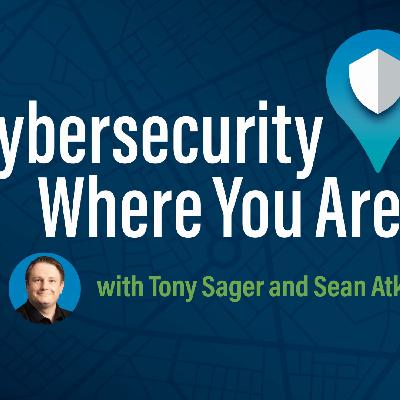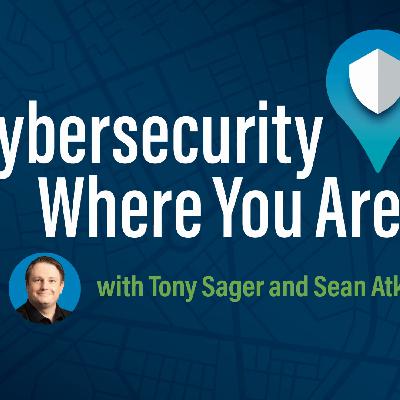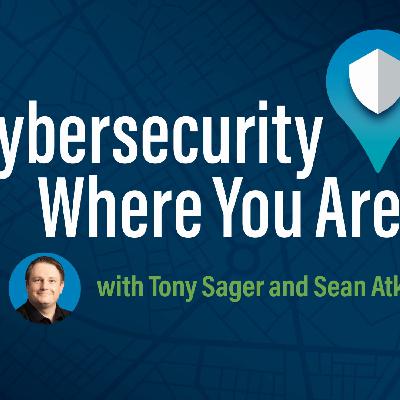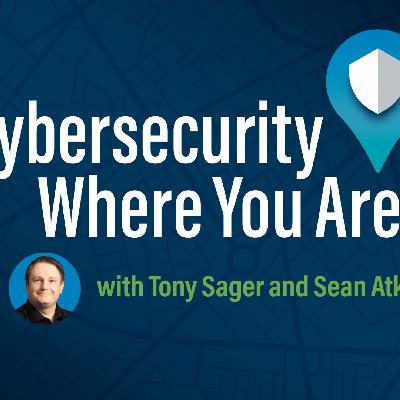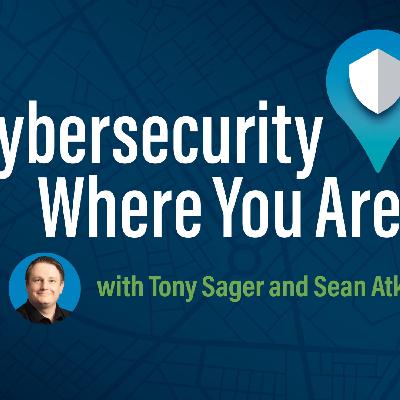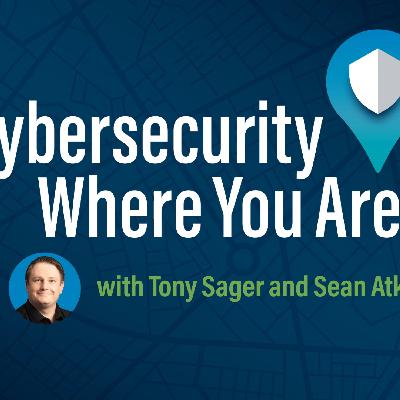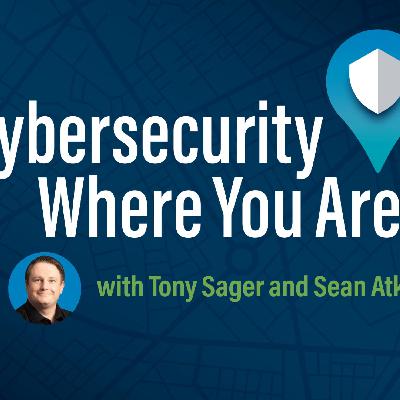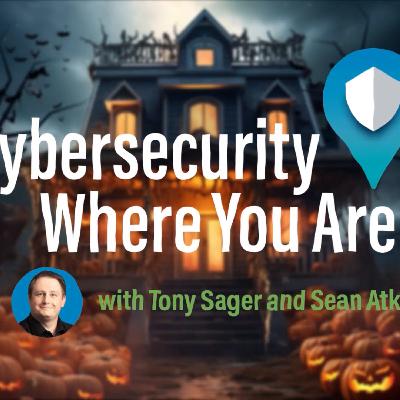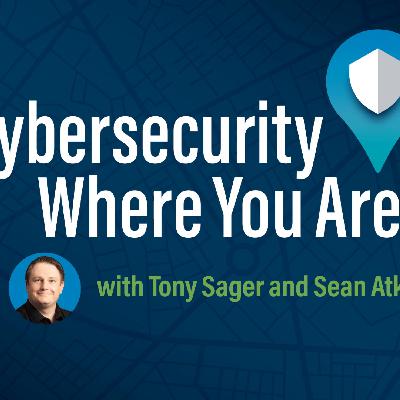Подборка Cybersecurity Where You Are (video)
Cybersecurity Where You Are (video)

Cybersecurity Where You Are (video)
Автор: Center for Internet Security
Подписка оформлена: 55Воспроизведенные: 1,475Подписаться
поделиться
© 2025
Описание
Welcome to video version of “Cybersecurity Where You Are,” the podcast of the Center for Internet Security® (CIS®). Cybersecurity affects us all — whether we’re online at home, managing a company, supporting clients, or running a state or local government. Join us on Wednesdays as Sean Atkinson, CISO at CIS, and Tony Sager, SVP & Chief Evangelist at CIS, discuss trends and threats, explore security best practices, and interview experts in the industry. Together, we’ll clarify these issues, creating confidence in the connected world. Subscribe to the audio version of our podcast here: https://fast.wistia.net/embed/channel/wbyhaw35xf?wchannelid=wbyhaw35xf.
167 Episodes
Reverse
In Episode 167 of Cybersecurity Where You Are, Sean Atkinson and Tony Sager sit down with Kelley Misata, Ph.D., Chief Trailblazer and Founder at Sightline Security. Together, they discuss how volunteers constitute a critical cybersecurity resource for the Center for Internet Security® (CIS®). Along the way, they explore the nature of volunteerism, the role of volunteers at CIS, and how CIS is looking to mature its engagement with volunteers going forward.Here are some highlights from our episode:01:37. Introductions to Kelley and her experience with cybersecurity volunteers03:09. Kelley's use of research, expertise, and an open mind to check in with CIS volunteers04:50. How volunteers have deepened their passion and dedication with CIS for 25 years06:55. Volunteers as a critical cybersecurity resource for "One CIS" going forward10:51. Commitment, conflict resolution, and openness to formal process in CIS Communities14:39. The use of directionality and accolades to encourage different types of contributors19:43. The importance of flexibility in management to meet volunteers where they are20:30. Leadership, storytelling, and recruitment as opportunities for volunteerism at CIS24:37. The risk of volunteer burnout and how to protect against it26:00. Collaboration with employers to treat volunteerism as a growth experience30:09. A balancing act of making volunteers useful without depleting the mission34:51. Sean's take: volunteer management as the original Large Language Model (LLM)38:32. Other observations and final thoughtsResources25 Years of Creating Confidence in the Connected WorldCIS CommunitiesEpisode 160: Championing SME Security with the CIS ControlsStoryCorpsIf you have some feedback or an idea for an upcoming episode of Cybersecurity Where You Are, let us know by emailing podcast@cisecurity.org.
In Episode 166 of Cybersecurity Where You Are, Sean Atkinson sits down with Tyler Moore, Ph.D., Chair of Cyber Studies at the University of Tulsa, and Daniel Woods, Lecturer at the University of Edinburgh. Together, they review the foundations of actuarial science in cyber risk.Here are some highlights from our episode:00:48. Introductions to Tyler and Daniel01:22. How actuarial science fits into a traditional approach of risk modeling02:20. Why cyber risk has historically been difficult to quantify04:01. How data sources available to insurers and individual organizations have evolved07:21. Adaptability as a key principle to model risk for an evolving cyber threat landscape08:58. Loss distribution modeling for different types of cyber threats11:38. Similarities and differences between how actuaries and frameworks view risks13:10. Quantifying severity, frequency, and resilience to different cyber risks14:31. How insurers differ from underwriters in their view of risk17:43. Ransomware as a case study where actuarial modeling improved risk management22:30. The value of translating cyber risk to business risk for CISOs like Sean26:20. Why data on which security controls matter most remains elusive32:33. The biggest misconceptions of using actuarial models in cybersecurity36:09. How cyber actuarial science can help to determine what works in cybersecurityResourcesEpisode 121: The Economics of Cybersecurity Decision-MakingEpisode 105: Context in Cyber Risk QuantificationEpisode 77: Data's Value to Decision-Making in CybersecurityHow Risk Quantification Tests Your Reasonable Cyber DefenseEpisode 113: Cyber Risk Prioritization as Ransomware DefenseEpisode 65: Making Cyber Risk Analysis Practical with QRAFAIR: A Framework for Revolutionizing Your Risk AnalysisIf you have some feedback or an idea for an upcoming episode of Cybersecurity Where You Are, let us know by emailing podcast@cisecurity.org.
In Episode 165 of Cybersecurity Where You Are, Tony Sager sits down with Valecia Stocchetti, Senior Cybersecurity Engineer at the Center for Internet Security® (CIS®), and Charity Otwell, Director of Critical Security Controls at CIS. Together, they take an in-depth look at implementing the CIS Critical Security Controls® (CIS Controls®), including what you need to know to begin your own CIS Controls implementation efforts.Here are some highlights from our episode:00:53. Introductions to Valecia and Charity02:48. How the CIS Controls ecosystem answers the deeper question of how to implement06:42. The importance of clear strategy, business priorities, and a realistic timeline09:56. How the CIS Community Defense Model (CDM) clarifies cyber defense priorities13:01. The use of calculations around costing to make a security program achievable15:31. Bringing IT and the Board of Directors together through governance20:36. "Herding cats" as a metaphor for navigating different compliance frameworks23:17. Why one prescriptive ask per CIS Safeguard starts cybersecurity workflows25:30. "Why" vs. "how" communication, accountability, staffing, budget, and continuous improvement as keys to success for CIS Controls implementation42:03. CIS Controls Assessment Specification as an answer to implementation subjectivity47:21. Parting thoughts around team effort, change, and CIS Controls AccreditationResourcesCloud Companion Guide for CIS Controls v8.1CIS Community Defense Model 2.0The Cost of Cyber Defense CIS Controls IG1Episode 132: Day One, Step One, Dollar One for CybersecurityPolicy TemplatesEpisode 107: Continuous Improvement via Secure by DesignReasonable Cybersecurity GuideCIS Controls ResourcesCIS Controls Assessment SpecificationEpisode 156: How CIS Uses CIS Products and ServicesCIS Controls AccreditationControls AccreditationEpisode 102: The Sporty Rigor of CIS Controls AccreditationIf you have some feedback or an idea for an upcoming episode of Cybersecurity Where You Are, let us know by emailing podcast@cisecurity.org.
In Episode 164 of Cybersecurity Where You Are, Tony Sager sits down with Curt Dukes, EVP and General Manager of Security Best Practices at the Center for Internet Security® (CIS®), and Steve Lipner, Executive Director of SAFECode.org. Together, they explore the evolution of secure software development and why secure by design is critical for reducing risk in today’s complex environments.Here are some highlights from our episode:01:08. Introductions to Curt and Steve04.01. The historical challenge of implementation errors in software security08:41. The emergence of secure by design and the need to measure against specified criteria14:39. The value of artifacts as evidence of secure software development28:52: How the CIS Critical Security Controls® (CIS Controls®) support secure software39:59. The use of community projects to address challenges like secure by designResourcesSecure by Design: A Guide to Assessing Software Security PracticesHow Secure by Design Helps Developers Build Secure SoftwareCIS, SAFECode Launch Secure by Design Guide to Help Developers Meet National Software Security ExpectationsEpisode 107: Continuous Improvement via Secure by DesignSecure by DesignSecure Software Development FrameworkEpisode 63: Building Capability and Integration with SBOMsIf you have some feedback or an idea for an upcoming episode of Cybersecurity Where You Are, let us know by emailing podcast@cisecurity.org.
In Episode 163 of Cybersecurity Where You Are, Sean Atkinson and Tony Sager sit down with Brock Boggs, Director of Technology at Cityscape Schools, and Maureen Kunac, Senior Product Manager at the Center for Internet Security® (CIS®). They dive into the realities and challenges of K-12 cybersecurity, including limited budgets, small teams, and growing threats.Brock shares how a ransomware incident at a neighboring school district and new state requirements pushed his district to take K-12 cybersecurity more seriously. He explains how CIS SecureSuite® tools gave him a clear starting point and helped him transform panic into progress. Maureen highlights how CIS continues to adapt its cybersecurity solutions for K-12 schools and why simplicity matters when resources are tight.Here are some highlights from our episode:00:47. Introductions to Brock and Maureen02:50. What prompted Cityscape Schools to prioritize cybersecurity and how Brock found CIS11:50. The importance of simplicity in making K-12 cybersecurity practical12:39. A collaborative journey of helping Brock get comfortable learning about cybersecurity22:52. A look back at Cityscape Schools pivoted to remote education during COVID-1934:20. Brock's advice for other school districts to get started with a cybersecurity programResourcesFormalizing K-12 Cybersecurity Policies in Less TimeHow to Plan a Cybersecurity Roadmap in 4 Steps2025 K-12 State of Cybersecurity Report: Where Education Meets Community ResilienceEpisode 142: SLTTs and Their Nuanced Cybersecurity Needs25 Years of Creating Confidence in the Connected WorldIf you have some feedback or an idea for an upcoming episode of Cybersecurity Where You Are, let us know by emailing podcast@cisecurity.org.
In Episode 162 of Cybersecurity Where You Are, Tony Sager sits down with Tina Williams-Koroma, Founder and CEO of TCecure, LLC and CyDeploy, Inc. Together, they discuss why "cyber insecurity is not inevitable" and how organizations can take a managed approach to attack surface management.Along the way, Tina shares her journey from software development to cybersecurity entrepreneurship and explains why proactive measures like hardening systems and automating patching are critical for reducing risk. Here are some highlights from our episode:00:50. Introductions to Tina, her career pivot, and her entrepreneurial path03:35. The value of the secure configuration guidance provided by the CIS Benchmarks®07:35. Why a well-managed system makes for a hard target11:00. Marketing against “magic” in a hype-driven cybersecurity market13:44. The translative work of moving well-managed infrastructure beyond "mere hygiene"19:14. Tina's faith-based inspiration for helping others get as far as she's gotten27:23. Soccer analogies for a managed attack surface33:54. Tina's pep talk: "Why cyber insecurity is not inevitable"38:38. Free cybersecurity resources for small businessesResourcesMapping and Compliance with the CIS BenchmarksGuide to Asset Classes: CIS Critical Security Controls v8.1Gartner Says That in the Age of GenAI, Preemptive Capabilities, Not Detection and Response, Are the Future of CybersecurityCIS Community Defense Model 2.0OwlThis — Powered By CyDeployIf you have some feedback or an idea for an upcoming episode of Cybersecurity Where You Are, let us know by emailing podcast@cisecurity.org.
In Episode 161 of Cybersecurity Where You Are, Sean Atkinson and Tony Sager are joined by Mishal Makshood, Azure Partner Alliance Manager at the Center for Internet Security® (CIS®), and David Kalish, Sr. Cybersecurity Solutions Engineer at CIS. Together, they explore how CIS Hardened Images® help to secure cloud environments and strengthen critical national infrastructure (CNI) resilience through collaboration.Mishal and David explain how these virtual machine images, which are pre-configured to the CIS Benchmarks®, serve as secure, scalable blueprints for cloud deployments. They highlight how CIS Hardened Images reduce human error, accelerate compliance, and foster trust across a global cybersecurity ecosystem that includes hyperscalers, supply chains, and public-private partnerships.Tony shares the origin story of the CIS Hardened Images and reflects on the evolution of cybersecurity from isolated efforts to a cooperative model built on shared standards and integrated tooling. The group also discusses how CIS Hardened Images align to frameworks and how they help organizations navigate multi-cloud environments while maintaining consistent security postures. Here are some highlights from our episode:00:50. Introductions to Mishal and David01:36. What CIS Hardened Images are and why they matter03:14. Why CIS Hardened Images are uniquely suited to strengthening CNI resilience04:24. The cultural shift toward working as an ecosystem to start from secure baselines06:34. The origin story of the CIS Hardened Images10:32. The value of taking guesswork out of secure configuration management in the cloud13:44. How CIS Hardened Images support compliance directly and through the CIS Critical Security Controls® (CIS Controls®)20:39. Building trust through cloud partnerships and collaboration28:50. The foundational role of configuration management in cybersecurity34:35. Getting started with strengthening your cloud security foundationResourcesCIS Hardened Images® ListSecure by Design: A Guide to Assessing Software Security PracticesSoftware Supply Chain Security25 Years of Creating Confidence in the Connected WorldMapping and Compliance with the CIS ControlsGuide to Implementation Groups (IG): CIS Critical Security Controls v8.1Build a Zero Trust Roadmap for FinServ with CIS SecureSuiteEpisode 154: Integration of Incident Response into DevSecOpsHow to Construct a Sustainable GRC Program in 8 StepsIf you have some feedback or an idea for an upcoming episode of Cybersecurity Where You Are, let us know by emailing podcast@cisecurity.org.
In Episode 160 of Cybersecurity Where You Are, Sean Atkinson and Tony Sager sit down with Alan Watkins, CIS Controls Ambassador, to explore how the CIS Critical Security Controls® (CIS Controls®) empower small and medium-sized enterprises (SMEs) to build practical, scalable cybersecurity programs.Alan shares his journey from law enforcement to IT leadership in the City of San Diego and how his passion for supporting SME security led him to become a champion of the CIS Controls. The episode highlights the importance of translating complex cybersecurity guidance into actionable steps that SMEs can realistically implement even with limited resources.Here are some highlights from our episode:00:49. Introductions to Alan, his career path, and his connection to the CIS Controls11:43. How Alan supports SMEs to mature their cybersecurity postures18:04. The work of CIS Controls Ambassadors to "memorialize" security best practices22:23. The need to translate how cyber hygiene supports business success25:31. CIS WorkBench and in-person communities as avenues to get involvedResourcesImplementation Guide for Small- and Medium-Sized Enterprises CIS Controls IG1Establishing Essential Cyber HygieneEpisode 132: Day One, Step One, Dollar One for CybersecurityEpisode 97: How Far We've Come preceding CIS's 25th BirthdayPCI & CIS: Partners in Data Security2024 DBIR Findings & How the CIS Critical Security Controls Can Help to Mitigate Risk to Your OrganizationPolicy TemplatesIf you have some feedback or an idea for an upcoming episode of Cybersecurity Where You Are, let us know by emailing podcast@cisecurity.org.
In episode 159 of Cybersecurity Where You Are, Sean Atkinson is joined by Joshua Palsgraf, Sr. Cyber Threat Intelligence Analyst at the Center for Internet Security® (CIS®), and Randy Rose, Vice President of Security Operations & Intelligence at CIS. Together, they dive into the scariest malware of 2025 in this special Halloween edition.The conversation explores what makes today’s malware truly terrifying, from stealthy threats that hide in plain sight to modular malware that evolves faster than defenses can adapt. The trio also discusses the corporatization of cybercrime, the rise of Malware as a Service, and how generative artificial intelligence (GenAI) is lowering the barrier to entry for cybercriminals.Here are some highlights from our episode:00:42. Introductions to Josh and Randy02:21. What makes the scariest malware of 2025 truly "scary"05:42. Evolution of malware: people, process, and technology09:33. How the corporatization of malware helps to democratize cybercrime11:25. The most "terrifying" malware strains of 202515:49. Malware reincarnation: Old threats with new masks17:20. GenAI as the great equalizer for cybercriminals, especially social engineers23:32. Defense-in-depth and threat-informed strategies24:45. Why incident response playbooks must evolve and become living documents27:02. What incident response looks like for cloud assets in the Fourth Industrial Revolution29:27. Naming malware after horror movie iconsResourcesMulti-State Information Sharing and Analysis Center®Episode 144: Carrying on the MS-ISAC's Character and CultureEpisode 126: A Day in the Life of a CTI AnalystA Short Guide for Spotting Phishing AttemptsThe CIS Security Operations Center (SOC): The Key to Growing Your SLTT's Cyber MaturityEpisode 157: How a Modern, Mission-Driven CIRT OperatesLiving Off the Land: Scheduled TasksCyber defenders sound the alarm as F5 hack exposes broad risksEpisode 134: How GenAI Lowers Bar for Cyber Threat ActorsActive Lumma Stealer Campaign Impacting U.S. SLTTsMS-ISAC Member-Reported Phishing Likely from Tycoon2FA PhaaSClickFix: An Adaptive Social Engineering TechniqueTop 10 Malware Q1 2025CTAs Leveraging Fake Browser Updates in Malware CampaignsItalian police freeze cash from AI-voice scam that targeted business leadersCornCon Cybersecurity ConferenceIf you have some feedback or an idea for an upcoming episode of Cybersecurity Where You Are, let us know by emailing podcast@cisecurity.org.
In episode 158 of Cybersecurity Where You Are, Sean Atkinson is joined by Andy Weidner, Product Manager at Nerdio, and Jason Ingalls, Chief Cybersecurity Officer at C3 Integrated Solutions. Together, they explore how organizations can navigate the complexities of Cybersecurity Maturity Model Certification (CMMC) compliance using automation, scalable infrastructure, and hardened cloud environments.The conversation dives into the challenges faced by managed service providers (MSPs) and defense contractors, the importance of baking in security from the start, and how Nerdio’s platform acts as a force multiplier for compliance and operational efficiency. Jason shares a compelling anecdote from his time in a security operations center (SOC), illustrating the real-world stakes of cybersecurity and the origins of CMMC.Here are some highlights from our episode:00:44. Introductions to Andy and Jason01:17. How to address common challenges of CMMC compliance03:40. A real-world story of data exfiltration and its national security impact08:34. How Nerdio and CIS Hardened Images® help organizations in their CMMC journey12:15. Understanding the vision to scale configuration management18:14. Strategy and automation as key elements to approaching CMMC Level 225:19. The value of baking scalability in vs. bolting it on26:38. Segregation of duties as a means of pursuing dual-scope CMMC certification29:22. Where to learn more about Nerdio and C3 Integrated SolutionsResourcesNerdioC3 Integrated SolutionsCIS Hardened Images®How to Plan a Cybersecurity Roadmap in 4 StepsCIS Controls v8.1 Mapping to CMMC 2.0CIS Controls v8.1 Mapping to NIST SP 800-53 Rev 5CIS Controls v8.1 Mapping to NIST SP 800-171 Rev 3If you have some feedback or an idea for an upcoming episode of Cybersecurity Where You Are, let us know by emailing podcast@cisecurity.org.
In episode 157 of Cybersecurity Where You Are, Sean Atkinson sits down with Matthew Grieco, Cyber Incident Response Team (CIRT) Principal Analyst at the Center for Internet Security® (CIS®), and Dustin Cox, CIRT Analyst at CIS. Together, they explore the unpredictable world of cyber incident response. From ransomware investigations to digital forensics, the team shares how they adapt to evolving threats, leverage open-source tools, and collaborate to support state and local governments. The conversation highlights the mission-driven mindset that fuels their work and the importance of continuous learning, effective communication, and teamwork in cybersecurity. Here are some highlights from our episode:00:44. Introductions to Matt and Dustin01:20. Inside the typically untypical day of a CIRT analyst05:33. Continuous learning and teamwork as ways to keep up with evolving threats07:38. Inside the cybersecurity tooling used by CIRT to support state and local governments14:51. How different skillsets on the team produce a unified incident response methodology19:26. The work of a mission-driven team to uncover root causes for security incidents25:52. An example of a case handled by Matt and Dustin30:16. How CIRT assesses potential talent and looks for problem solversResourcesMulti-State Information Sharing and Analysis Center®The CIS Security Operations Center (SOC): The Key to Growing Your SLTT's Cyber MaturityEpisode 152: Driving Response Time While Enriching TelemetryEpisode 126: A Day in the Life of a CTI AnalystCombatting RansomwareIf you have some feedback or an idea for an upcoming episode of Cybersecurity Where You Are, let us know by emailing podcast@cisecurity.org.
In episode 156 of Cybersecurity Where You Are, Sean Atkinson and Tony Sager are joined by Stephanie Gass, Sr. Director of Information Security at Center for Internet Security® (CIS®), and Angelo Marcotullio, Chief Information Officer at CIS. Together, they explore how CIS practices what it preaches by using CIS products and services internally, which includes implementation of the CIS Critical Security Controls® (CIS Controls®) and CIS Benchmarks®, automation, and alignment to compliance frameworks. Their discussion highlights how CIS builds a strong cybersecurity foundation while adapting to evolving threats and regulatory requirements.The conversation dives into practical applications, cultural alignment, and the importance of repeatable processes for scaling security across new products and services. It also touches on the role of privacy regulations, cyber risk quantification, and the community-driven approach that underpins CIS best practices. Here are some highlights from our episode:01:12. Why CIS “drinks its own champagne” when it comes to cybersecurity02:56. Three ways the CIS Controls help modern enterprises defend against threat actors04:02. The importance of pulling together security lessons learned in a way that's translatable10:03. Our use of the CIS Controls to align to SOC 2, ISO 27001, and other frameworks12:01. How governance, risk, and compliance (GRC) engineering works with automation to help build repeatable processes22:43. The role of collaboration and communication in building a cybersecurity program27:17. Privacy regulations as a catalyst for security innovation30:24. The CIS Community Defense Model and evidence-based practices32:40. How CIS leverages lessons learned to improve our security best practicesResourcesEpisode 146: What Security Looks Like for a Security CompanyImplementation Guide for Small and Medium-Sized Enterprises CIS Controls IG1How to Construct a Sustainable GRC Program in 8 StepsMapping and Compliance with the CIS ControlsCIS Completes SOC 2 Type II Audit Using CIS Best PracticesEpisode 74: The Nexus of Cybersecurity & Privacy LegislationCIS Community Defense Model 2.0Episode 121: The Economics of Cybersecurity Decision-MakingEpisode 77: Data's Value to Decision-Making in CybersecurityCIS CommunitiesIf you have some feedback or an idea for an upcoming episode of Cybersecurity Where You Are, let us know by emailing podcast@cisecurity.org.
In episode 155 of Cybersecurity Where You Are, Tony Sager is joined by John Gilligan, President and Chief Executive Officer (CEO) of the Center for Internet Security® (CIS®). Together, they reflect on 25 years of progress for CIS and look ahead to the future. They explore the driving forces behind "CIS 2.0," including the shift toward addressing multidimensional threats, expanding CIS’s audience, and leveraging tools driven by generative artificial intelligence (GenAI). Their discussion highlights how CIS is adapting to a new era while staying true to its mission-driven roots and foundational principles. Here are some highlights from our episode:01:11. The need for a mission-driven nonprofit to support the role of government04:28. Understanding the primary catalyst behind CIS 2.005:53. Multidimensional threats, expanded audiences, and revamped tools as adaptive opportunities12:57. The challenge of linking technology risk to operational risk13:45. How attackers tend to be more systems-level thinkers than defenders15:50. Culture as a support system for navigating the evolving skills and processes of CIS 2.022:24. Collaboration, partnerships, mission focus, and culture as foundational CIS elements31:11. How our engagement with state and local governments, thought leadership, and products and services will change going forward40:47. Parting thoughts and an important reminderResources25 Years of Creating Confidence in the Connected WorldEpisode 119: Multidimensional Threat Defense at Large EventsStrengthening Critical Infrastructure: SLTT Progress & PrioritiesEnhanced Cyber Resilience as a Secure Cyber CityThe CIS Security Operations Center (SOC): The Key to Growing Your SLTT's Cyber MaturityEpisode 115: Continuous Feedback as CIS Employee CultureEpisode 125: How Leadership Principles Influence CIS CultureCIS CultureCIS CommunitiesEpisode 97: How Far We've Come preceding CIS's 25th BirthdayWhy Whole-of-State Cybersecurity Is the Way ForwardAn Introduction to Artificial IntelligenceReasonable CybersecurityIf you have some feedback or an idea for an upcoming episode of Cybersecurity Where You Are, let us know by emailing podcast@cisecurity.org.
In episode 154 of Cybersecurity Where You Are, Sean Atkinson discusses incident response in DevSecOps, exploring challenges and solutions in modern software development. He emphasizes the importance of integrating security into development processes and speaks about common issues like alert fatigue and software supply chain vulnerabilities. Here are some highlights from our episode:01:32. Common challenges with modern software development03:54. High-speed and continuous deployment07:08. Incident correlation with cloud deployment strategies10:00. Software supply chain vulnerabilities12:45. Alert fatigue and false positives14:30. Testing and automation as enablers of real-time anomaly detection17:40. The responsibility of incident responders to understand what they see18:58. Automated control and a projectized approach to implementing zero trust21:26. Oversight and governance with artificial intelligence and machine learning23:24. Continuous improvement and early detection28:08. Continuous monitoring and logging, automation, and incident response drills30:03. Moving down a path of helping incident responders become culturally awareResourcesCloud Security and the Shared Responsibility ModelCIS Software Supply Chain Security GuideAn Introduction to Artificial IntelligenceDefense-in-Depth: A Necessary Approach to Cloud SecurityEpisode 63: Building Capability and Integration with SBOMsEpisode 44: A Zero Trust Framework Knows No EndLeveraging Generative Artificial Intelligence for Tabletop Exercise DevelopmentIf you have some feedback or an idea for an upcoming episode of Cybersecurity Where You Are, let us know by emailing podcast@cisecurity.org.
In episode 153 of Cybersecurity Where You Are, Sean Atkinson is joined by Jason Ashong, IT Support Specialist at the Center for Internet Security® (CIS®). Jason shares his journey from tinkering with tech as a kid to working in IT and pursuing cybersecurity research. The conversation covers education, mentorship, hands-on experience, and advice for newcomers entering the field. Here are some highlights from our episode:01:10. Jason’s early days in IT of fixing devices and breaking things to learn02:14. First professional IT/helpdesk experience at Dutchess Community College03:48. The importance of mentors pushing you to grow06:02. Jason’s advice to students of understanding foundational computing knowledge08:45. The value of technical skills in networking, cryptography, and coding11:00. Hands-on experience through labs, competitions, and research projects16:08. Self-confidence, practice, and dedicated time as tips for navigating the job market19:29. The role of attitude in opening up new opportunities24:40. Jason flips the script and interviews SeanMistakes to avoid when entering the field: imposter syndrome and perfectionismCybersecurity as a path of continuous learningOpportunities for newcomers with experience in artificial intelligence and data scienceResourcesEpisode 129: Embedding Cybersecurity in Project ManagementEpisode 95: AI Augmentation and Its Impact on Cyber DefenseEpisode 44: A Zero Trust Framework Knows No EndTryHackMeHack The BoxIf you have some feedback or an idea for an upcoming episode of Cybersecurity Where You Are, let us know by emailing podcast@cisecurity.org.
In episode 152 of Cybersecurity Where You Are, Sean Atkinson is joined by Cliff Moten, Manager, Cybersecurity Solutions Engineering at the Center for Internet Security® (CIS®); and Richard Vargas, Security Operations Center Manager at CIS. Together, they discuss how the 24x7x365 CIS Security Operations Center (SOC) and CIS Managed Detection and Response™ (CIS MDR™) work together to accelerate response time while enriching telemetry. Here are some highlights from our episode:01:40. Demystifying SOCs and MDR as cybersecurity concepts02:52. How the CIS SOC works to provide information, context, and next steps for an event05:04. Artificial intelligence and automation as ways to accelerate response time10:20. Real-world instances where a fast response time made a difference13:10. What it means to support underfunded organizations with the resources they need17:22. The role of contextual cyber threat intelligence in accelerating response times19:01. The value of security orchestration, automation, and response (SOAR) in helping defenders move quickly27:33. Lessons that organizations can use to cut down on their incident response timesResourcesThe CIS Security Operations Center (SOC): The Key to Growing Your SLTT's Cyber MaturityEpisode 148: How MDR Helps Shine a Light on Zero-Day AttacksEpisode 144: Carrying on the MS-ISAC's Character and CultureEpisode 137: National Cybersecurity Through SLTT ResilienceCombatting RansomwareEstablishing Essential Cyber HygieneCIS Community Defense Model 2.0If you have some feedback or an idea for an upcoming episode of Cybersecurity Where You Are, let us know by emailing podcast@cisecurity.org.
In episode 151 of Cybersecurity Where You Are, Sean Atkinson and Tony Sager conclude their mid-year review of 12 Center for Internet Security® (CIS®) experts' cybersecurity predictions for 2025. Here are some highlights from our episode:01:12. The importance of consolidating security operations and using what already exists03:18. The promise of generative artificial intelligence (GenAI) in relieving grunt work08:26. The great responsibility and burden of integrating GenAI into business operations10:53. How control and inspection generate trust in systems17:57. Post-quantum cryptography, IoT in edge computing, and GenAI's sociopolitical risks30:21. The need for a more holistic understanding of compliance33:34. Why zero trust doesn't mean "no trust"36:56. The need for AI as an element of critical security control41:33. The dynamic challenge of protecting all assets with varying levels of securityResources12 CIS Experts' Cybersecurity Predictions for 2025Episode 145: 2025 Cybersecurity Predictions H2 Review — Pt 1Episode 135: Five Lightning Chats at RSAC Conference 2025Establishing Essential Cyber HygieneEpisode 95: AI Augmentation and Its Impact on Cyber DefenseGuide to Asset Classes: CIS Critical Security Controls v8.1An Examination of How Cyber Threat Actors Can Leverage Generative AI PlatformsAn Introduction to Artificial IntelligenceEpisode 120: How Contextual Awareness Drives AI GovernanceEpisode 118: Preparing for Post-Quantum CryptographyEpisode 63: Building Capability and Integration with SBOMsEpisode 99: How Cyber-Informed Engineering Builds ResilienceMapping and Compliance with the CIS ControlsMapping and Compliance with the CIS BenchmarksCIS Community Defense Model 2.0If you have some feedback or an idea for an upcoming episode of Cybersecurity Where You Are, let us know by emailing podcast@cisecurity.org.
In episode 150 of Cybersecurity Where You Are, Sean Atkinson and Tony Sager are joined by Chad Rogers, Sr. Manager, Digital Media Services, at the Center for Internet Security® (CIS®); Rudy Uhde, Video Editor at CIS; and David Bisson, Sr. Content Strategist at CIS. Together, they use a roundtable chat to celebrate 150 episodes of Cybersecurity Where You Are. Here are some highlights from our episode:01:33. How the cybersecurity landscape and podcast have changed since Episode 10005:40. The "labor of love" that goes into editing and preparing an episode for publication12:13. Memorable guests and moments that changed the team's thinking about cybersecurity25:45. How the larger podcast team drives continuous improvement and innovation30:13. Parting thoughts for the audienceResourcesEpisode 100: Celebrating 100 Episodes and Looking AheadEpisode 149: Human Error, AI Missteps, and Other VM RisksEpisode 9: Mitigating Risk: Information Security GovernanceEpisode 96: Making Continuous Compliance Actionable for SMBsEpisode 121: The Economics of Cybersecurity Decision-MakingEpisode 114: 3 Board Chairs Reflect on 25 Years of CommunityEpisode 136: How WiCyS Advances Women in CybersecurityEpisode 120: How Contextual Awareness Drives AI GovernanceEpisode 116: AI-Enhanced Ransomware and Defending Against ItEpisode 146: What Security Looks Like for a Security CompanyEpisode 110: How Security Culture and Corporate Culture MeshIf you have some feedback or an idea for an upcoming episode of Cybersecurity Where You Are, let us know by emailing podcast@cisecurity.org.
In episode 149 of Cybersecurity Where You Are, Sean Atkinson is joined by Chris McCullar, Director of Sales, Cloud Security, at the Center for Internet Security® (CIS®); and Mishal Makshood, Sr. Cloud Security Account Executive at CIS. Together, they discuss how to navigate human error, artificial intelligence (AI) missteps, and other landmarks in a new frontier of virtual machine (VM) risks. Here are some highlights from our episode:00:50. Introductions with Chris and Mishal02:20. The ongoing need to address the risk of human error when configuring VMs04:55. The value of building trusted security into a VM image by design07:28. A reality check of what the shared responsibility model means to an organization13:06. How the integration of AI into DevOps accelerates both automation and mistakes15:21. The importance of a secure foundation in the cloud on which you can build with AI18:19. Automated enforcement and AI's role in complementing human judgment21:03. Two examples how CIS resources can drive governance and policy integration28:05. Cybersecurity as a community-driven team sport30:33. Lifecycle management as a way of addressing organizations' security needsResourcesKeep the Cloud Secure with CIS after Migrating to the CloudAutomated Compliance: The Byproduct of Holistic HardeningMeet the Shared Responsibility Model with New CIS ResourcesEpisode 135: Five Lightning Chats at RSAC Conference 20252025 Data Breach Investigations ReportIf you have some feedback or an idea for an upcoming episode of Cybersecurity Where You Are, let us know by emailing podcast@cisecurity.org.
In episode 148 of Cybersecurity Where You Are, Sean Atkinson is joined by Rob Reese, Cyber Incident Response Team Manager at the Center for Internet Security® (CIS®); Dustin Cox, Cyber Incident Response Team Analyst at CIS; and Cliff Moten, Manager, Cybersecurity Solutions Engineering at CIS. Together, they discuss how organizations can use Managed Detection and Response (MDR) tools to help defend against zero-day attacks. Here are some highlights from our episode:01.06. Demystifying zero-day vulnerabilities with a definition02:36. Why zero-day attacks are some of the most serious threats facing organizations today04:19. Examples of zero-day exploits and how these threats affect Incident Response (IR)10:06. The importance of understanding your environment and patch management13:58. How MDR assists with behavioral analysis, assembling holistic inventories, and IR20:02. The role of asset inventories in determining scope and containing a zero-day incident24:08. Why it's important to have humans managing and monitoring an MDR solution27:11. MDR as a means of centralizing evidence of a zero-day attack30:05. Parting thoughts for those concerned with their endpoint security postureResourcesCIS Managed Detection and Response™ (CIS MDR)Multi-State Information Sharing and Analysis Center®CIS Critical Security Control 1: Inventory and Control of Enterprise AssetsCIS Critical Security Control 2: Inventory and Control of Software AssetsThe CIS Security Operations Center (SOC): The Key to Growing Your SLTT's Cyber MaturityReal-Time Indicator FeedsIncident Response Policy Template for CIS Control 17If you have some feedback or an idea for an upcoming episode of Cybersecurity Where You Are, let us know by emailing podcast@cisecurity.org.


